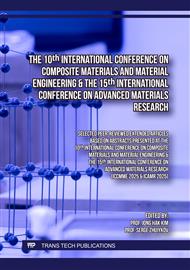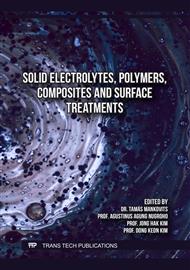p.25
p.37
p.45
p.57
p.67
p.75
p.81
p.97
p.105
Functionalization of MWCNTs and Graphite for Enhanced Composite Properties
Abstract:
This study investigates an enhancement of carbon-based materials, including multi-walled carbon nanotubes (MWCNTs) and graphite, through Ion Assisted Reaction (IAR) and metal nanoparticle deposition using Physical Vapor Deposition. The IAR process employed Ar+ ion beams in reactive gas environments, effectively introducing hydrophilic functional groups such as hydroxyl (-OH) and carboxyl (-COOH) on the MWCNT surfaces. This modification significantly improved dispersion behavior of the treated MWCNTs, particularly in non-polar solvents like N-Methyl-2-pyrrolidone (NMP). Results indicated that the treated MWCNTs demonstrated a slower sedimentation rate compared to untreated samples, with enhanced stability over 120 minutes in NMP. Graphite was modified with copper nanoparticles on its surface using magnetron sputtering in PVD system, leading to a uniform distribution of the modified graphite in matrix. SEM analysis revealed that this modification enhanced the surface roughness of the graphite, facilitating stronger interfacial adhesion with polymer epoxy resin. Composites incorporating these nanoparticle-coated graphite fillers (NPP graphite) exhibited superior thermal and mechanical properties. For instance, a 15% increment in thermal conductivity was observed in epoxy resin composites containing NPP graphite compared to those with untreated graphite. This improvement was attributed to the metallic Cu nanoparticles acting as thermal bridges, effectively transferring heat within the composite matrix. Mechanical properties were evaluated by blending modified fillers into polymer matrices, including polyvinyl chloride (PVC) and polyethylene (PE), with filler concentrations varying from 5 vol% to 15 vol%. Tensile testing and SEM analysis of the fractured surfaces indicated that NPP graphite composites achieved uniform dispersion, reduced agglomeration, and improved interfacial bonding. This study demonstrates that physical surface modification techniques such as IAR and PVD effectively overcome limitations associated with conventional chemical methods. This approach not only improves the dispersion and interfacial adhesion of carbon-based fillers but also enhances their thermal and mechanical performance.
Info:
Periodical:
Pages:
67-74
Citation:
Online since:
May 2025
Price:
Сopyright:
© 2025 Trans Tech Publications Ltd. All Rights Reserved
Share:
Citation:



